-
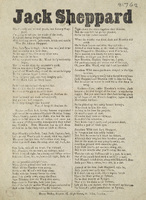
This particular ballad was written approximately a full decade after Sheppard died in 1724, evidence of his lasting hold on the public imagination. The ballad mentions the highwayman Joseph "Blueskin" Blake, an accomplice of Sheppard known for his violent inclinations. Sheppard and Blake did work together to rob Jack's apprentice-master. However, the accounts of this ballad are only partially correct. Sheppard was Wood's apprentice in carpentry, but before that, he was apprenticed to William Kneebone. Kneebone, rather than Wood, was the victim of this betrayal. There is also no record of Sheppard killing Mrs. Wood.
-
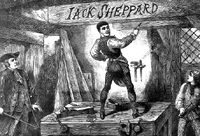
-
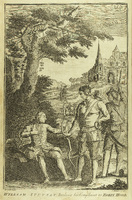
This volume of tales and ballads demonstrates the public desire for stories of crime, even in the elite social circle that could purchase such a large and well-illustrated history. Robin Hood is perhaps the most legendary criminal narrative. Many stories of this mythic figure were told as ballads, the earliest surviving, “Robin Hood and the Monk,” dating back to the 15th century. Both Jack Sheppard and Blueskin Blake can also be found in this collection.
-
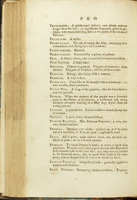
As shown in this dictionary of Cant and slang, to “prig” is to steal (as used in "The policeman who prigged the mutton"). “Thieves Cant,” otherwise known as “Argot” or “Low Speech,” was a jargon commonly used by criminals, beggars, hustlers, and vagabonds of the time. Cant was a common feature in publications about thieves and other criminals. The jargon is commonly believed to derive many words from Angloromani, the language of the Romani people. This dictionary was annotated by its owner and its spare pages contain scrawled puns, quotes, and dirty jokes.
-
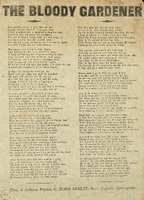
"The Bloody Gardener," in some versions titled "The Bloody Gardener's Cruelty," tells the story of a young nobleman who falls in love with a shepherd's daughter. Disapproving the match, his mother hires her gardener to murder the young woman. A dove informs the nobleman of the death. He then confronts his mother and kills himself, to be buried alongside the shepherdess. Thwarted love is an often repeated ballad theme and "The Bloody Gardener" appeared in a variety of printings, the first instance being 1754. Ballads such as this demonstrate the mingling of fictional tale and journalistic narrative in the broadside trade.
...
David Atkinson. The Bloody Gardener’s Cruelty: A Contextual History, Folklore 130, no. 3 (2019): 258-281.
-
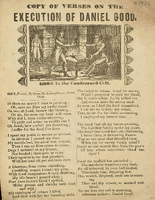
The Seven Dials, where this broadside was produced, was one of the worst slums in London at the time. In the 17th century, it became the center of the ballad trade. A group of London’s most prolific balladeers called themselves the “Seven Bards of the Seven Dials.” Criminal confessions were frequently printed in broadsides, either collected from the condemned themselves or fabricated completely by the balladeer. They often took a moralistic tone that, nonetheless, made sure to share all the gory details.
-
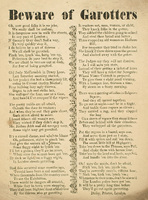
Despite a general decline in street crime during this period, there were two major moral panics over "garroting" in 1856 and 1862. Garroting is a method of strangulation used in robberies, where the thief uses a length of rope or wire to grab the victim from behind. However, in this context, it can mean mugging in general. Because of a few high-profile robbery cases and a large amount of press coverage, anxieties about the safety of London streets were on the rise. This ballad encourages the London police and the general public to beware of thieves and to "stick 'em, lick 'em, pinch 'em."
...
Sindall, R. (1987). "The London Garotting Panics of 1856 and 1862". Social History 12, no. 3 (1987) : 351–359.
-
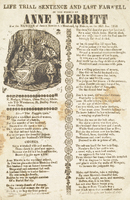
This ballad tells of Anne Merritt, convicted of poisoning her husband in exchange for a "paltry sum of money" from the Hackney Benefit Society (referred to as a "Burial Society" in the ballad). Benefit societies such as these were early precursors to life insurance policies. Merritt was initially sentenced to be hung. However, doubts were cast on the medical evidence for her conviction. Though she might have received a verdict of not-guilty due to a lack of conclusive evidence, Merritt was unable to afford legal defense. In the end, she was exiled to Australia, leaving behind three children. The press focus on this case later led to reforms in the trial process, preventing a reliance on unchallenged singular sources.
-

This lamentation tells the story of a man named Keene, convicted of killing his wife's son and sentenced to execution at Horsemonger Lane Gaol. "Lamentations of Keene," is told from Keene's perspective and details his remorse for the murder and his dread of judgement. Whether or not it was actually written by Keene is doubtful, though balladeers did occasionally interview prisoners for an extra "edge."
-
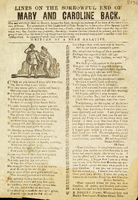
This ballad tells the story of the murders of sisters Mary and Caroline Back by Caroline's lover, Didea Readanies a Spanish Legionnaire, who believed that Caroline was pregnant and that she intended to break up with him. The ballad emphasizes "not only murder but seduction, it was this villain's base intent" and encourages young women to be wary of foreign soldiers.
-
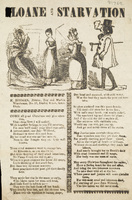
This ballad details the events of the Sloane scandal of 1850. Mr. and Mrs. Sloane starved, beat, and tortured their young housekeeper, Jane Wilbred. Both would plead guilty to all charges brought against them. The case acquired both national and international attention as an example of British class cruelty. In "Bleak House and the Sloane Scandal of 1850 Again," Trevor Blount argues that some of Charles Dickens' writings may even have been inspired by this event.
...
Blount, Trevor. “‘Bleak House’ and the Sloane Scandal of 1850 Again.” Dickens Studies 3, no. 1 (1967): 63–67. http://www.jstor.org/stable/44390618.
-
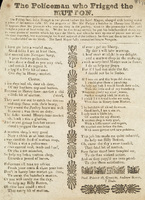
The classic ballad was constructed of alternating four-beat and three-beat lines, arranged into four-line verses with each even-numbered line rhyming. Usually, the broadside would present a combination of news report and ballad, with a summary of the event printed first. Rather than printing a new musical score, balladeers would often compose to the tune of hymns or folk songs. Occasionally a broadside ballad will elaborate: "to be sung to the tune of...'" but it is often assumed that the public will know the melody.
-
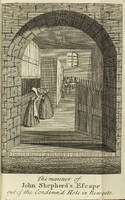
"A narrative of all the robberies, escapes, &c. of John Sheppard" is thought to have been ghostwritten by Daniel Defoe, though the original author is unconfirmed. He would have based this account on his conversations with Jack Sheppard at Newgate prison. The biography sold “quickly and abundantly” on the day of Sheppard’s execution and is credited with much of Sheppard’s celebrity. This woodcut print depicts Sheppard’s escape from the condemned hold of Newgate in broad daylight with the help of his lovers and accomplices, Elizabeth Lyon and Poll Maggot.












